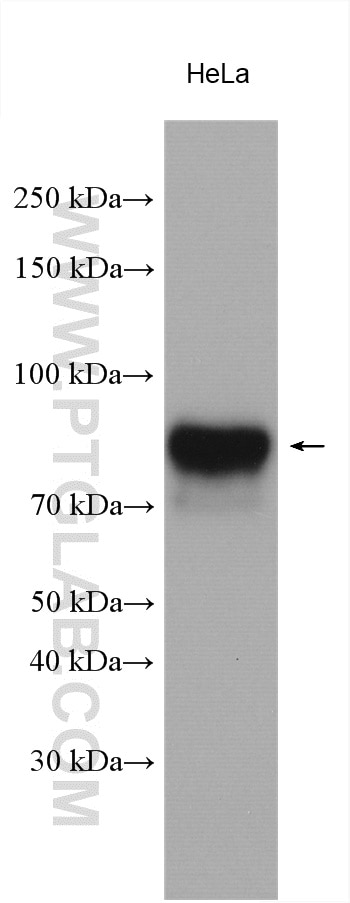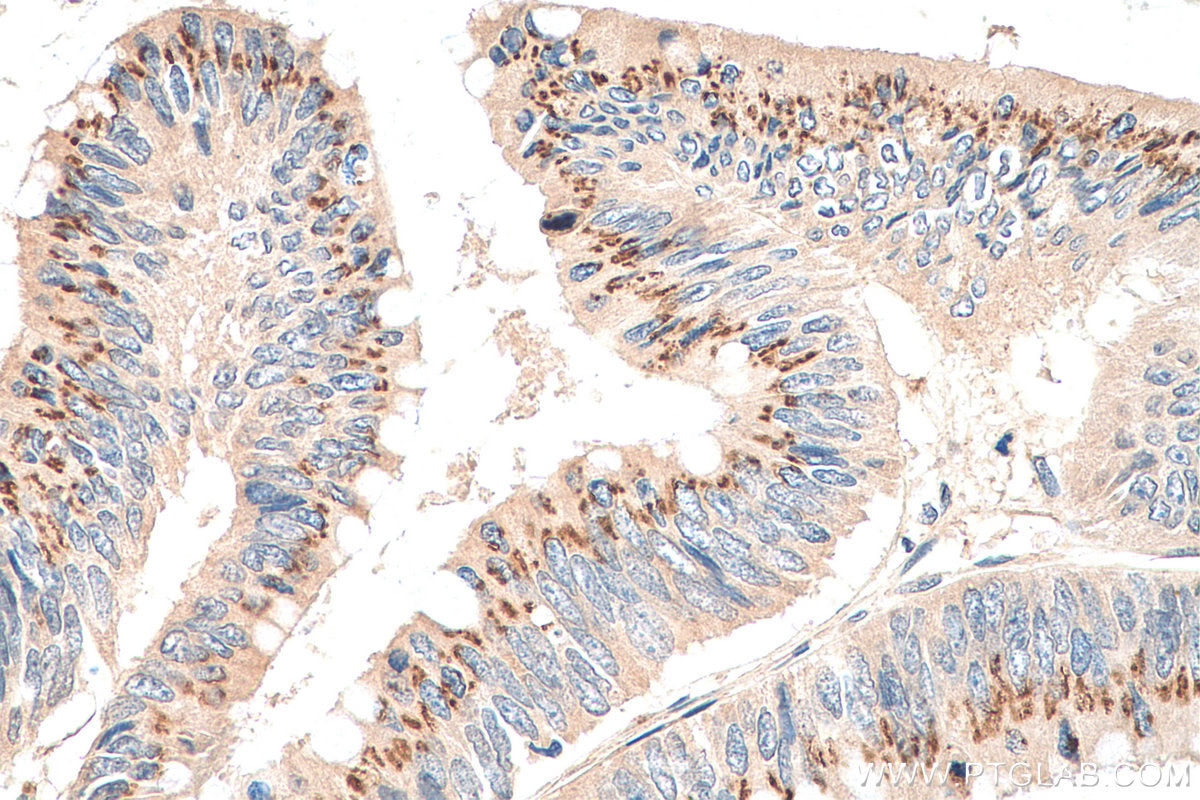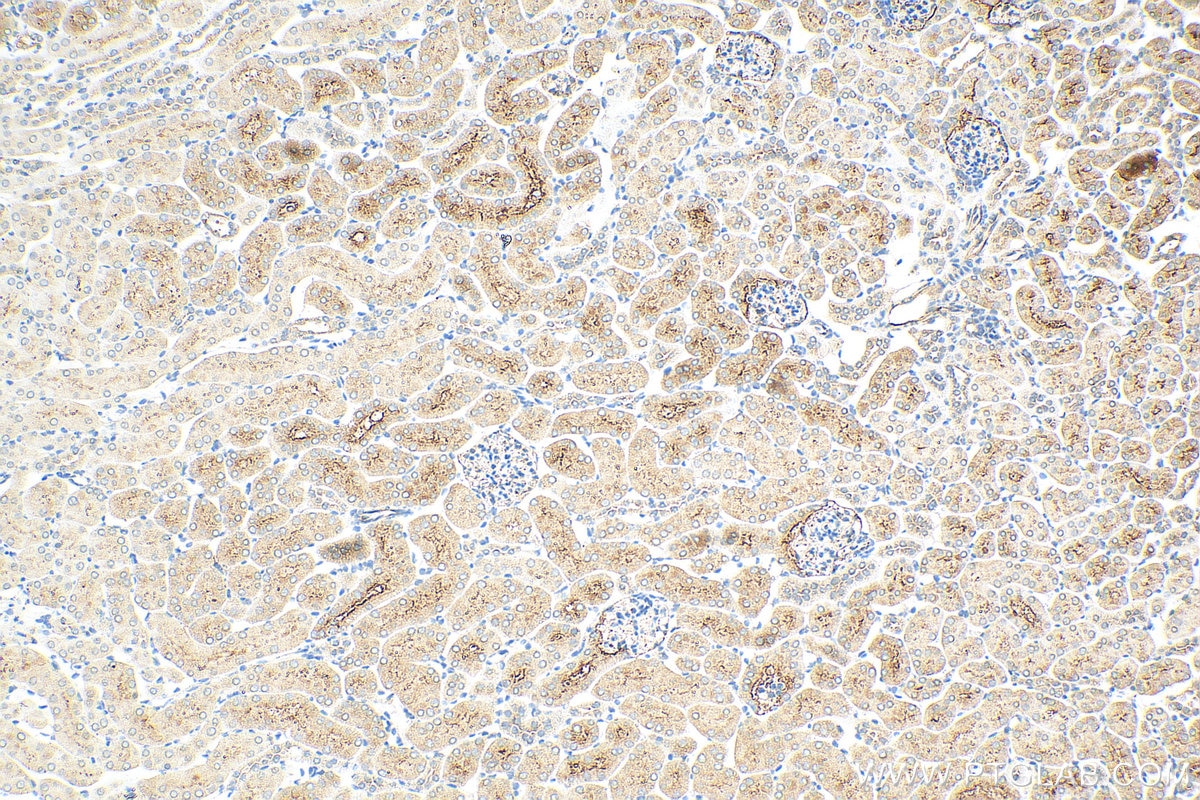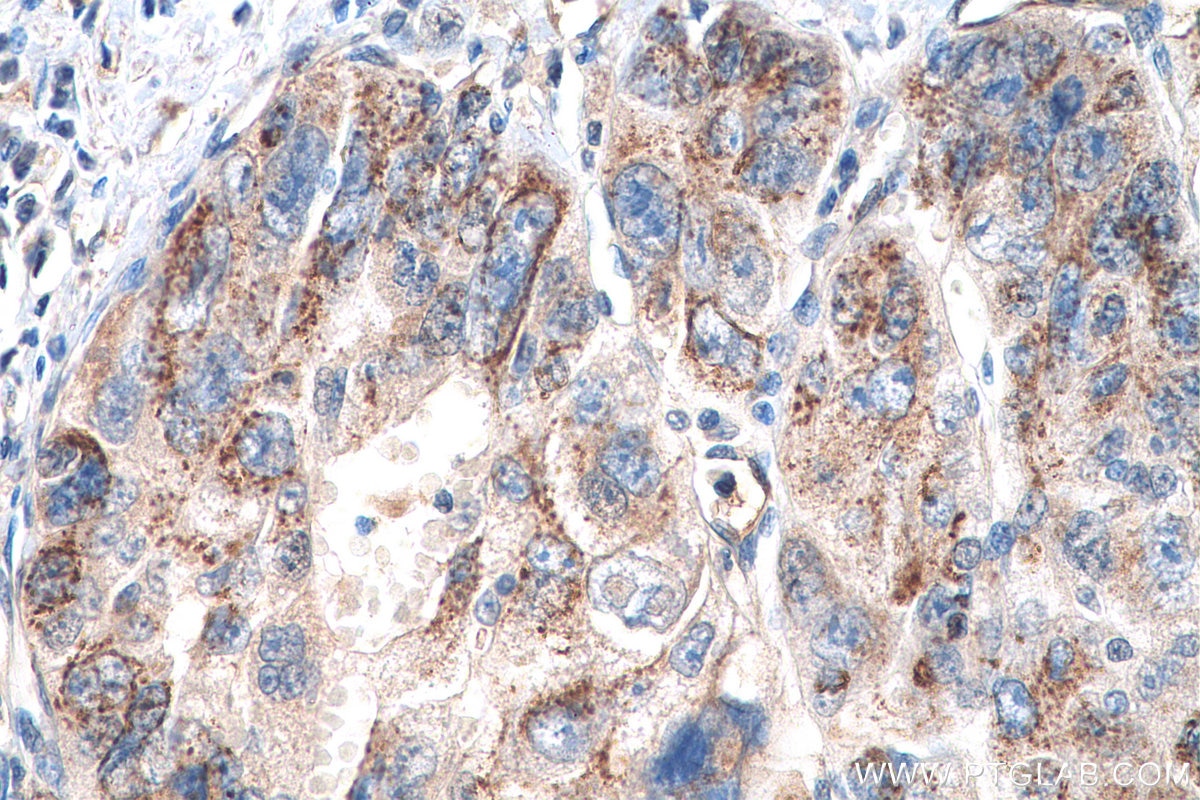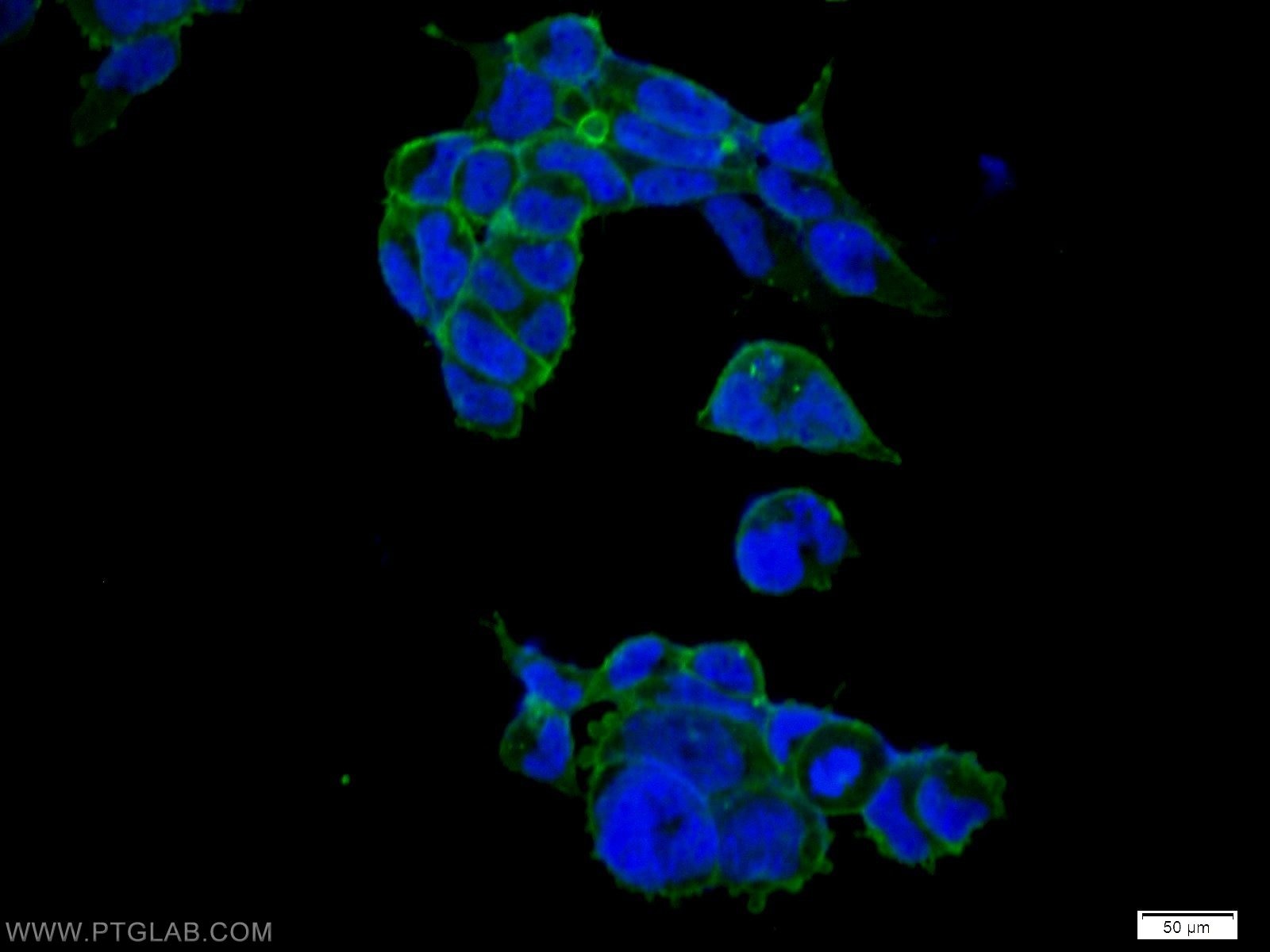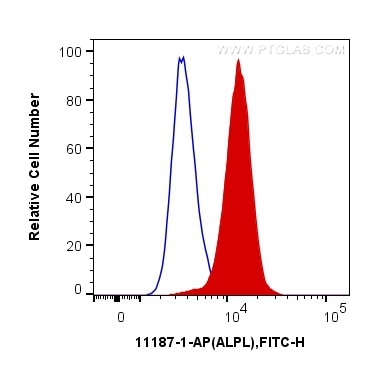Tested Applications
| Positive WB detected in | HeLa cells |
| Positive IHC detected in | human colon cancer tissue, human liver cancer tissue, mouse kidney tissue Note: suggested antigen retrieval with TE buffer pH 9.0; (*) Alternatively, antigen retrieval may be performed with citrate buffer pH 6.0 |
| Positive IF/ICC detected in | HEK-293 cells |
| Positive FC (Intra) detected in | HeLa cells |
Recommended dilution
| Application | Dilution |
|---|---|
| Western Blot (WB) | WB : 1:500-1:2000 |
| Immunohistochemistry (IHC) | IHC : 1:200-1:800 |
| Immunofluorescence (IF)/ICC | IF/ICC : 1:50-1:500 |
| Flow Cytometry (FC) (INTRA) | FC (INTRA) : 0.20 ug per 10^6 cells in a 100 µl suspension |
| It is recommended that this reagent should be titrated in each testing system to obtain optimal results. | |
| Sample-dependent, Check data in validation data gallery. | |
Published Applications
| KD/KO | See 1 publications below |
| WB | See 52 publications below |
| IHC | See 24 publications below |
| IF | See 12 publications below |
| ChIP | See 1 publications below |
Product Information
11187-1-AP targets ALPL in WB, IHC, IF/ICC, FC (Intra), chIP, ELISA applications and shows reactivity with human samples.
| Tested Reactivity | human |
| Cited Reactivity | human |
| Host / Isotype | Rabbit / IgG |
| Class | Polyclonal |
| Type | Antibody |
| Immunogen |
CatNo: Ag1664 Product name: Recombinant human ALPL protein Source: e coli.-derived, PGEX-4T Tag: GST Domain: 23-330 aa of BC021289 Sequence: EKDPKYWRDQAQETLKYALELQKLNTNVAKNVIMFLGDGMGVSTVTAARILKGQLHHNPGEETRLEMDKFPFVALSKTYNTNAQVPDSAGTATAYLCGVKANEGTVGVSAATERSRCNTTQGNEVTSILRWAKDAGKSVGIVTTTRVNHATPSAAYAHSADRDWYSDNEMPPEALSQGCKDIAYQLMHNIRDIDVIMGGGRKYMYPKNKTDVEYESDEKARGTRLDGLDLVDTWKSFKPRYKHSHFIWNRTELLTLDPHNVDYLLGLFEPGDMQYELNRNNVTDPSLSEMVVVAIQILRKNPKGFFLL Predict reactive species |
| Full Name | alkaline phosphatase, liver/bone/kidney |
| Calculated Molecular Weight | 57 kDa |
| Observed Molecular Weight | 80 kDa |
| GenBank Accession Number | BC021289 |
| Gene Symbol | ALPL |
| Gene ID (NCBI) | 249 |
| RRID | AB_2305523 |
| Conjugate | Unconjugated |
| Form | Liquid |
| Purification Method | Antigen affinity purification |
| UNIPROT ID | P05186 |
| Storage Buffer | PBS with 0.02% sodium azide and 50% glycerol, pH 7.3. |
| Storage Conditions | Store at -20°C. Stable for one year after shipment. Aliquoting is unnecessary for -20oC storage. 20ul sizes contain 0.1% BSA. |
Background Information
There are at least four distinct but related alkaline phosphatases: intestinal, placental, placental-like, and liver/bone/kidney (tissue non-specific). The product of this gene is a membrane bound glycosylated enzyme that is not expressed in any particular tissue and is, therefore, referred to as the tissue-nonspecific form of the enzyme. ALPL(Alkaline phosphatase, tissue-nonspecific isozyme) is also named as AP-TNAP, TNSALP and belongs to the alkaline phosphatase family. It can exsit as a homodimer with the molecular weight of 140 kDa(PMID:18724009). ALPL was synthesized as a 66-kDa endo-b-N-acetylglucos-aminidase H (Endo H)-sensitive form, and processed to an 80-kDa mature form, which is anchored to the plasma membrane via glycosylphosphatidylinositol (GPI)(PMID:10839996).This antibody can bind the four mentioned alkaline phosphatases.
Protocols
| Product Specific Protocols | |
|---|---|
| FC protocol for ALPL antibody 11187-1-AP | Download protocol |
| IF protocol for ALPL antibody 11187-1-AP | Download protocol |
| IHC protocol for ALPL antibody 11187-1-AP | Download protocol |
| WB protocol for ALPL antibody 11187-1-AP | Download protocol |
| Standard Protocols | |
|---|---|
| Click here to view our Standard Protocols |
Publications
| Species | Application | Title |
|---|---|---|
Mol Ther Nucleic Acids Circular RNA circSmoc1-2 regulates vascular calcification by acting as a miR-874-3p sponge in vascular smooth muscle cells. | ||
Virol Sin Establishment and characterization of a new cell culture system for hepatitis B virus replication and infection. | ||
J Cell Physiol Cell dynamics in Hertwig's epithelial root sheath are regulated by β-catenin activity during tooth root development. | ||
ACS Biomater Sci Eng Polydopamine-Coated Poly(l-lactide) Nanofibers with Controlled Release of VEGF and BMP-2 as a Regenerative Periosteum. | ||
Front Cell Dev Biol Nrf2 Activation Is Involved in Cyclic Mechanical Stress-Stimulated Osteogenic Differentiation in Periodontal Ligament Stem Cells via PI3K/Akt Signaling and HO1-SOD2 Interaction. |
Reviews
The reviews below have been submitted by verified Proteintech customers who received an incentive for providing their feedback.
FH Charlotte (Verified Customer) (07-25-2024) | I tested the antibody with the following protocol. The most intense band corresponds to ALP. There is a lot of background. Maybe cell line specific as C3H10T1/2 cells are differentiating into the osteoblast lineage upon stimulation ? Blocking 1h in 5% milk in TBST primary incubation 1/1000 in blocking solution, O.N. at 4°C wash 5*5min TBST secondary incubation 1/5000 in blocking solution, 1h at RT° wash 4*5min PBST + 5min PBS
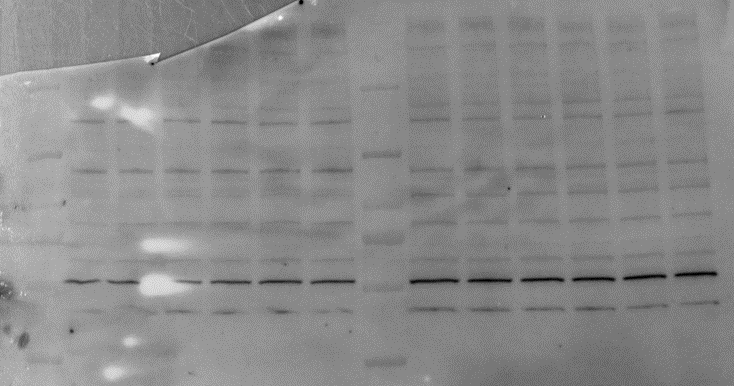 |
FH CHAO (Verified Customer) (03-31-2022) | Weak bands may due to tissue specificity
|
FH LUNFENG (Verified Customer) (01-27-2020) | GOOD
|
FH Jie (Verified Customer) (01-23-2020) | Smear band but with the right product size on western blot. Immunohistochemical staining showed desired results in control versus knockout mouse model
|
FH Jingwen (Verified Customer) (01-17-2020) | This antibody worked very well and showed the specific band around 70kDa in western blot.
|

